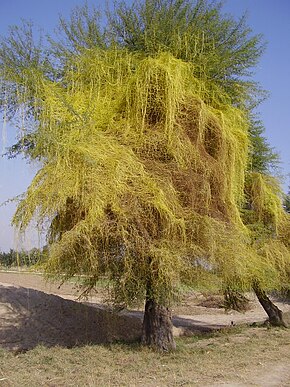
Back نبات طفيلي Arabic Паразитно растение Bulgarian Planta paràsita Catalan Phytoparasitismus German Parazita planto Esperanto Planta parásita Spanish Parasiittaim Estonian گیاه انگل Persian Loiskasvi Finnish Plante parasite French

A parasitic plant is a plant that derives some or all of its nutritional requirements from another living plant. They make up about 1% of angiosperms and are found in almost every biome. All parasitic plants develop a specialized organ called the haustorium, which penetrates the host plant, connecting them to the host vasculature – either the xylem, phloem, or both.[1] For example, plants like Striga or Rhinanthus connect only to the xylem, via xylem bridges (xylem-feeding). Alternately, plants like Cuscuta and some members of Orobanche connect to both the xylem and phloem of the host.[1][2][3] This provides them with the ability to extract resources from the host. These resources can include water, nitrogen, carbon and/or sugars.[4] Parasitic plants are classified depending on the location where the parasitic plant latches onto the host (root or stem), the amount of nutrients it requires, and their photosynthetic capability.[5] Some parasitic plants can locate their host plants by detecting volatile chemicals in the air or soil given off by host shoots or roots, respectively. About 4,500 species of parasitic plants in approximately 20 families of flowering plants are known.[5][6]
There is a wide range of effects that may occur to a host plant due to the presence of a parasitic plant. Often there is a pattern of stunted growth in hosts especially in hemi-parasitic cases, but may also result in higher mortality rates in host plant species following introduction of larger parasitic plant populations.[7]
- ^ a b Kokla, Anna; Melnyk, Charles W. (2018-10-01). "Developing a thief: Haustoria formation in parasitic plants". Developmental Biology. 442 (1): 53–59. doi:10.1016/j.ydbio.2018.06.013. ISSN 0012-1606. PMID 29935146. S2CID 49394142.
- ^ Kuijt, Job (1969). The biology of parasitic flowering plants. Berkeley: University of California Press. ISBN 0-520-01490-1. OCLC 85341.
- ^ Heide-Jørgensen, Henning (2008). Parasitic flowering plants. BRILL. doi:10.1163/ej.9789004167506.i-438. ISBN 9789047433590.
- ^ Smith, David (January 2000). "The Population Dynamics and Community Ecology of Root Hemiparasitic Plants". The American Naturalist. 155 (1): 13–23. doi:10.1086/303294. PMID 10657173. S2CID 4437738.
- ^ a b Heide-Jørgensen, Henning S. (2008). Parasitic flowering plants. Leiden: Brill. ISBN 978-9004167506.
- ^ Nickrent, D. L. and Musselman, L. J. 2004. Introduction to Parasitic Flowering Plants. The Plant Health Instructor. doi:10.1094/PHI-I-2004-0330-01 [1] Archived 2016-10-05 at the Wayback Machine
- ^ Smith, David (January 2000). "The Population Dynamics and Community Ecology of Root Hemiparasitic Plants". The American Naturalist. 155 (1): 13–23. doi:10.1086/303294. ISSN 0003-0147. PMID 10657173. S2CID 4437738.